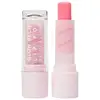What's inside
What's inside
 Key Ingredients
Key Ingredients

No key ingredients
 Benefits
Benefits

 Concerns
Concerns

 Ingredients Side-by-side
Ingredients Side-by-side

Water
Skin ConditioningCocamidopropyl Betaine
CleansingGlycerin
HumectantPEG-7 Glyceryl Cocoate
EmulsifyingPolysorbate 20
EmulsifyingPropylene Glycol
HumectantPolyacrylate Crosspolymer-6
Emulsion StabilisingPhenoxyethanol
PreservativeSaccharomyces/Xylinum/Black Tea Ferment
Skin ConditioningVaccinium Myrtillus Fruit Extract
Skin ConditioningParfum
MaskingSodium Gluconate
Skin ConditioningHydroxyethylcellulose
Emulsion StabilisingPotassium Sorbate
PreservativeSodium Citrate
BufferingSorbic Acid
PreservativeCitric Acid
BufferingBiotin
AntiseborrhoeicCI 16035
Cosmetic ColorantCI 42090
Cosmetic ColorantWater, Cocamidopropyl Betaine, Glycerin, PEG-7 Glyceryl Cocoate, Polysorbate 20, Propylene Glycol, Polyacrylate Crosspolymer-6, Phenoxyethanol, Saccharomyces/Xylinum/Black Tea Ferment, Vaccinium Myrtillus Fruit Extract, Parfum, Sodium Gluconate, Hydroxyethylcellulose, Potassium Sorbate, Sodium Citrate, Sorbic Acid, Citric Acid, Biotin, CI 16035, CI 42090
Polyglyceryl-2 Triisostearate
EmulsifyingPolyethylene
AbrasiveCaprylic/Capric Triglyceride
MaskingDiisostearyl Malate
EmollientPentaerythrityl Tetraisostearate
EmollientPhytosteryl/Isostearyl/Cetyl/Stearyl/Behenyl Dimer Dilinoleate
Skin ConditioningHydrogenated Polyisobutene
EmollientOctyldodecanol
EmollientTridecyl Trimellitate
EmollientTrioctyldodecyl Citrate
EmollientDipentaerythrityl Hexahydroxystearate/Hexastearate/Hexarosinate
Skin ConditioningMacadamia Seed Oil Polyglyceryl-6 Esters Behenate
EmollientSynthetic Wax
AbrasiveSilica Dimethyl Silylate
EmollientCitrullus Lanatus Seed Oil
EmollientCoconut Flower Sugar
AntioxidantIsostearic Acid
CleansingSucrose
HumectantCitrullus Lanatus Fruit Extract
Skin ConditioningHibiscus Sabdariffa Flower Extract
Skin ConditioningTocopherol
AntioxidantStearalkonium Hectorite
Gel FormingEthylene/Propylene Copolymer
AbrasivePropylene Carbonate
SolventEuphorbia Cerifera Wax
Citric Acid
BufferingMaltodextrin
AbsorbentCopernicia Cerifera Wax
Dehydroacetic Acid
PreservativePropylene Glycol
HumectantWater
Skin ConditioningMalic Acid
BufferingAscorbic Acid
AntioxidantTartaric Acid
BufferingCrataegus Monogyna Flower Extract
Skin ConditioningPotassium Sorbate
PreservativeViola Tricolor Extract
EmollientCI 45410
Cosmetic ColorantCI 15850
Cosmetic ColorantCI 19140
Cosmetic ColorantParfum
MaskingSodium Benzoate
MaskingPolyglyceryl-2 Triisostearate, Polyethylene, Caprylic/Capric Triglyceride, Diisostearyl Malate, Pentaerythrityl Tetraisostearate, Phytosteryl/Isostearyl/Cetyl/Stearyl/Behenyl Dimer Dilinoleate, Hydrogenated Polyisobutene, Octyldodecanol, Tridecyl Trimellitate, Trioctyldodecyl Citrate, Dipentaerythrityl Hexahydroxystearate/Hexastearate/Hexarosinate, Macadamia Seed Oil Polyglyceryl-6 Esters Behenate, Synthetic Wax, Silica Dimethyl Silylate, Citrullus Lanatus Seed Oil, Coconut Flower Sugar, Isostearic Acid, Sucrose, Citrullus Lanatus Fruit Extract, Hibiscus Sabdariffa Flower Extract, Tocopherol, Stearalkonium Hectorite, Ethylene/Propylene Copolymer, Propylene Carbonate, Euphorbia Cerifera Wax, Citric Acid, Maltodextrin, Copernicia Cerifera Wax, Dehydroacetic Acid, Propylene Glycol, Water, Malic Acid, Ascorbic Acid, Tartaric Acid, Crataegus Monogyna Flower Extract, Potassium Sorbate, Viola Tricolor Extract, CI 45410, CI 15850, CI 19140, Parfum, Sodium Benzoate
 Reviews
Reviews

Ingredients Explained
These ingredients are found in both products.
Ingredients higher up in an ingredient list are typically present in a larger amount.
Citric Acid is an alpha hydroxy acid (AHA) naturally found in citrus fruits like oranges, lemons, and limes.
Like other AHAs, citric acid can exfoliate skin by breaking down the bonds that hold dead skin cells together. This helps reveal smoother and brighter skin underneath.
However, this exfoliating effect only happens at high concentrations (20%) which can be hard to find in cosmetic products.
Due to this, citric acid is usually included in small amounts as a pH adjuster. This helps keep products slightly more acidic and compatible with skin's natural pH.
In skincare formulas, citric acid can:
While it can provide some skin benefits, research shows lactic acid and glycolic acid are generally more effective and less irritating exfoliants.
Most citric acid used in skincare today is made by fermenting sugars (usually from molasses). This synthetic version is identical to the natural citrus form but easier to stabilize and use in formulations.
Read more about some other popular AHA's here:
Learn more about Citric AcidParfum is a catch-all term for an ingredient or more that is used to give a scent to products.
Also called "fragrance", this ingredient can be a blend of hundreds of chemicals or plant oils. This means every product with "fragrance" or "parfum" in the ingredients list is a different mixture.
For instance, Habanolide is a proprietary trade name for a specific aroma chemical. When used as a fragrance ingredient in cosmetics, most aroma chemicals fall under the broad labeling category of “FRAGRANCE” or “PARFUM” according to EU and US regulations.
The term 'parfum' or 'fragrance' is not regulated in many countries. In many cases, it is up to the brand to define this term.
For instance, many brands choose to label themselves as "fragrance-free" because they are not using synthetic fragrances. However, their products may still contain ingredients such as essential oils that are considered a fragrance by INCI standards.
One example is Calendula flower extract. Calendula is an essential oil that still imparts a scent or 'fragrance'.
Depending on the blend, the ingredients in the mixture can cause allergies and sensitivities on the skin. Some ingredients that are known EU allergens include linalool and citronellol.
Parfum can also be used to mask or cover an unpleasant scent.
The bottom line is: not all fragrances/parfum/ingredients are created equally. If you are worried about fragrances, we recommend taking a closer look at an ingredient. And of course, we always recommend speaking with a professional.
Learn more about ParfumPotassium Sorbate is a preservative used to prevent yeast and mold in products. It is commonly found in both cosmetic and food products.
This ingredient comes from potassium salt derived from sorbic acid. Sorbic acid is a natural antibiotic and effective against fungus.
Both potassium sorbate and sorbic acid can be found in baked goods, cheeses, dried meats, dried fruit, ice cream, pickles, wine, yogurt, and more.
You'll often find this ingredient used with other preservatives.
Learn more about Potassium SorbatePropylene Glycol is an odorless, colorless liquid. As a humectant, it helps skin retain moisture. It also aids in delivering active ingredients.
Another role of this ingredient is preventing a product from melting or freezing. Propylene glycol also adds antimicrobrial properties to a product, elongating product lifespan.
This ingredient is considered an organic alcohol and commonly added into both cosmetics and foods.
Those with sensitive skin or conditions may develop a rash when using this ingredient.
Learn more about Propylene GlycolWater. It's the most common cosmetic ingredient of all. You'll usually see it at the top of ingredient lists, meaning that it makes up the largest part of the product.
So why is it so popular? Water most often acts as a solvent - this means that it helps dissolve other ingredients into the formulation.
You'll also recognize water as that liquid we all need to stay alive. If you see this, drink a glass of water. Stay hydrated!
Learn more about Water